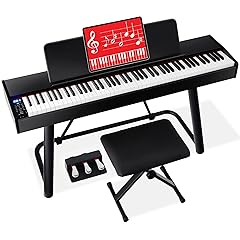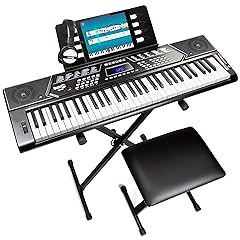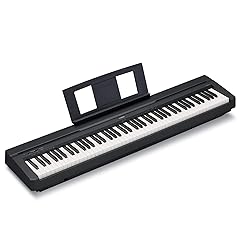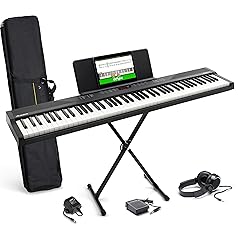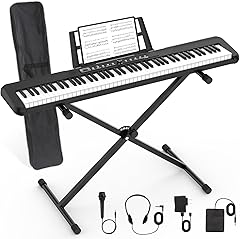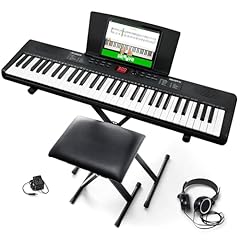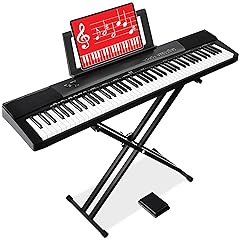-
1
Best Overall Full-size, weighted keys for authentic feel.
Full-size, weighted keys for authentic feel. Includes stand, stool, and pedal unit.
Includes stand, stool, and pedal unit. Dual headphone jacks for quiet practice.
Dual headphone jacks for quiet practice. -
2
 Complete set with stand, bench, and headphones.
Complete set with stand, bench, and headphones. Includes Simply Piano app for easy learning.
Includes Simply Piano app for easy learning. Pitch bend feature adds expressive playability.
Pitch bend feature adds expressive playability. -
3
 Authentic feel with 88 weighted keys.
Authentic feel with 88 weighted keys. Compact design fits small spaces.
Compact design fits small spaces. Includes sustain pedal and power supply.
Includes sustain pedal and power supply. -
4
 Wide variety of 480 instrument sounds.
Wide variety of 480 instrument sounds. Includes essential accessories for beginners.
Includes essential accessories for beginners. USB MIDI connectivity enhances versatility.
USB MIDI connectivity enhances versatility. -
5
 Authentic feel with graded hammer standard action.
Authentic feel with graded hammer standard action. Compact design suitable for small spaces.
Compact design suitable for small spaces. Simple controls for easy sound customization.
Simple controls for easy sound customization. -
6
 Full-size, semi-weighted keys for realistic feel.
Full-size, semi-weighted keys for realistic feel. Comes with a complete beginner accessory set.
Comes with a complete beginner accessory set. Portable design with a convenient carrying case.
Portable design with a convenient carrying case. -
7
 Comprehensive bundle with stand and bench included.
Comprehensive bundle with stand and bench included. 300 different sounds for versatile play.
300 different sounds for versatile play. Includes music lessons for beginners.
Includes music lessons for beginners. -
8
 Semi-weighted keys offer realistic touch and feel.
Semi-weighted keys offer realistic touch and feel. Includes essential accessories for convenient setup.
Includes essential accessories for convenient setup. USB-MIDI compatibility enhances learning experience.
USB-MIDI compatibility enhances learning experience. -
9
 User-friendly interface ideal for beginners.
User-friendly interface ideal for beginners. Comes with essential accessories included.
Comes with essential accessories included. Lightweight design for easy portability.
Lightweight design for easy portability. -
10
Best Affordable Semi-weighted keys offer realistic playing experience.
Semi-weighted keys offer realistic playing experience. Includes stand and sustain pedal for convenience.
Includes stand and sustain pedal for convenience. Multiple voice settings enhance musical versatility.
Multiple voice settings enhance musical versatility.
Overview of Keyboard Piano
In today's digital age, learning to play the piano has become more accessible than ever, thanks to the wide variety of keyboard pianos available. Whether you're a beginner eager to explore the world of music or a seasoned musician seeking a portable practice instrument, finding the right keyboard piano can enhance your musical journey. This review guide is designed to help you discover the best keyboard pianos, focusing on features such as sound quality, portability, and user-friendly design. With the right keyboard piano, you can enjoy the joy of music-making and improve your skills, all from the comfort of your home.Top Keyboard Piano
• Best Choice 88-Key Weighted Digital Piano Set• RockJam 61-Key Keyboard Piano Kit• Yamaha P71 88-Key Digital PianoFAQ
Q: What should I consider when buying a keyboard piano for beginners?
A: When buying a keyboard piano for beginners, consider the number of keys, touch sensitivity, and built-in learning features. A 61-key keyboard piano is often sufficient for beginners, and touch sensitivity helps mimic the feel of an acoustic piano. Look for models with instructional features or apps to make learning more engaging.
Q: How does a keyboard piano differ from a traditional piano?
A: A keyboard piano is more portable and often more affordable than a traditional piano. While it offers various sounds and features, it typically lacks the acoustic piano's natural resonance. However, modern keyboard pianos often include weighted keys to better replicate the feel of playing a traditional piano.
Q: Can I connect a keyboard piano to a computer for music production?
A: Yes, most modern keyboard pianos can be connected to a computer for music production. Look for a keyboard piano with a USB or MIDI output. This allows you to use music software to record, edit, and produce your own compositions, making it a great tool for aspiring musicians.
Q: How important is polyphony in a keyboard piano?
A: Polyphony is crucial in a keyboard piano as it dictates how many notes can be played simultaneously. Higher polyphony is better, allowing for more complex music without cutting off notes. Aim for at least 64-note polyphony for a more versatile playing experience, especially if you use the sustain pedal frequently.
Q: What are the benefits of learning on a keyboard piano with weighted keys?
A: Learning on a keyboard piano with weighted keys can significantly improve your playing technique. Weighted keys mimic the resistance of an acoustic piano, helping to build finger strength and control. This makes the transition to a traditional piano smoother if you decide to pursue it later on.

